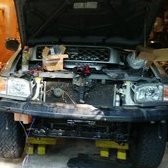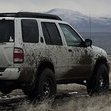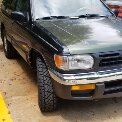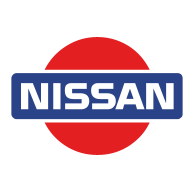-
Posts
2,541 -
Joined
-
Last visited
-
Days Won
270
hawairish last won the day on April 11
hawairish had the most liked content!
About hawairish
- Birthday 01/17/1980
Previous Fields
-
Your Pathfinder Info
2004 Nissan Pathfinder SE 4WD
-
Mechanical Skill Level
Standalone Tool Chest Mechanic
-
Your Age
41-45
-
What do you consider yourself?
I Go When I Can
-
Model
SE
-
Year
2004
Profile Information
-
Gender
Male
-
Location
Surprise, AZ
-
Country
United States
hawairish's Achievements

NPORA Old-Timer (5/5)
2k
Reputation
-
My reason for asking about any special features on your LE headlights is because there could also be a control module in place. Long time ago a buddy had an Infiniti J30 where the headlights kept flickering or turning off random; would work fine for a while, then not work. I spent hours tracing the issue and eventually took a real hard look at a headlight control module under the hood. Took it all apart and found a couple solder joints on the back of the control board had hairline cracks. Resoldered it, problem solved. I know there were some premium headlight options, I'm just not sure what they were aside from leveling options. I haven't scoured the FSM to see what options there were. In your case, you still may want to just swap bulbs and wait it out to see if the problem travelled.
-
Mine didn't have the washer or mesh washer, and it didn't look like anything had been replaced previously...stock manifold and uppers as far as I could tell. I looked for those items, too. The upper had a lip that seemed to fit well into the manifold opening, and sealed fine when bolted together. Looked on RA and couldn't find suitable replacements, and sure as hell wasn't paying $20/ea x 4 items to replace items that weren't there and didn't seem to present a problem. But, looking at RA now, I see a Fel-Pro mesh washer (p/n 61339) is on closeout for $3.33/ea that I don't recall seeing previously apparently because it only shows up in a search by OE p/n, and not by my application. Fel-Pro 60835 reads like it might be the washer ("Converter; Manifold To Converter") but it has no matching OE p/n and zero specs...it looks too small and of one OE p/n it does list, it returns as a match for the gasket that goes between the upper cat and lower cat/resonator. Looking at a pic of the washer, it's hard to tell if it crushes; looks like it has squared edges. Frankly, I'm not even sure what the mesh accomplishes, but maybe I'll pick some up.
-
hawairish started following Rear Lower trailing arms 1997 Pathfinder , Headlight , Cat Removal and 2 others
-
I’d start by swapping the bulbs left <-> right and see if the issue travels. Inspect the wires for any issues. With a multimeter in continuity mode and lights off, you can try probing the low and high signals to see if there’s continuity, suggesting a short somewhere. Then, with test voltage/signal on low and high when on. Just both headlight sockets for consistency. My guess (and lowest hanging fruit) is the bulb, maybe something odd going on internally…wild guess. Does your LE have anything special about its headlights? I thought some had optional adjustment or different bulbs/lenses vs. SE models. Not sure.
-
I’d advise against impacts unless you ended up needing to just shearing something on purpose. I prefer to feel those out, even stopping to reapply penetrant. For the heat shields, there are a few screws that hold them on, so even if you shear a couple you might be okay. Obviously oil on a heat source is not ideal, but worst case might be a large hose clamp securing the heat shield.
-
Even with the lower cat+pipes off, the proximity of the manifold/upper joint to the chassis still makes accessing all the nuts (6 per side) difficult. That’s where the extensions are needed, mainly for the ones at the top or towards the chassis. I replaced what I could with what I could on hand. I think in one case that meant replacing a bust stud with a bolt after extracting the stud and re-tapping the hole (holes…pretty sure I re-tapped everything). Can’t confirm if leaks are common. Mine seemed ok, but I did replace the gasket on the drivers side. I absolutely avoided doing anything on the passenger side. The heat shield blocks everything, and just gaining visibility to things seemingly required pulling the steering pump and reservoir, among many other things. Right now with my SAS project still underway, I have those components out and it’s still largely out of sight. I expect the coolant pipe also obstructs things, so that’d have to be drained. I’ll try to get a pic of things tonight since I have things cleared out of the space.
-
I did everything from the bottom (3.5L). In fact, only way I could really even get up there was with the lower cats off (or resonators on some models). Getting the head shields off the uppers was the tough part…a few 10mm are in very tight spots. Some sheared off due to rust. Penetrant wouldn’t hurt. Once the shields are off, you’ll still need/want socket extensions and wobbles to give yourself leverage below the chassis…working space is still tight. Access to the RH upper O2 sucks. All others are easy (LH upper from the top). I can’t remember if everything was nuts, but I want to say some were bolts. I know I sheared a couple on the drivers side and had to pull the exhaust manifold off to repair. Passenger side is a nightmare…fortunately didn’t have to remove that manifold and didn’t shear any. Also, I basically needed to remove the entire exhaust system to pull the uppers off. There wasn’t enough slack in the hangers to pry things backwards, so I removed everything starting from the rear.
-

Death Wobble repair kit, does this cover it?
hawairish replied to DonutHands's topic in 96-2004 R50 Pathfinders
@EricCR Forget OEM. 10x https://belmetric.com/m14x1-5-fine-din-6921-flange-bolt-class-10-9-wrench-18mm/?sku=BFD14X1.5X80YLW @ $3.54/ea 10x https://belmetric.com/din-6927-fine-full-wrench-class-10-top-lock-flange-nut/ @ $1.54/ea Class 10/10.9 hardware, yellow zinc, OEM size and function (prevailing torque lock nut). Only real downside is they are not JIS spec, so they need different size wrenches than you'd normally use on the truck (18mm and 21mm). Buy 10 sets because there's a price break that's less than a buck more (8 @ $49.92 vs 10 @ $50.80 before tax/shipping). Haven't used Belmetric before, but will be soon. -

Rear Lower trailing arms 1997 Pathfinder
hawairish replied to AR97Pathfinder's topic in 96-2004 R50 Pathfinders
Yep, one bolt per side. -

Rear Lower trailing arms 1997 Pathfinder
hawairish replied to AR97Pathfinder's topic in 96-2004 R50 Pathfinders
Camber bolts wouldn't hurt, but also probably unnecessary at that height/setup. I didn't use them until my SFD days. -

Rear Lower trailing arms 1997 Pathfinder
hawairish replied to AR97Pathfinder's topic in 96-2004 R50 Pathfinders
If I'm being honest, I'm brand agnostic for stuff like this. I have enough conspiracy theories in my head that prevents me from believing one part is better than another; and in many cases, they're the identical and made by the same company. My wallet tends to be my decision maker in those cases. If you eventually plan to swap the bushings for poly, though, I'd keep it cheap. But that's because I'm cheap (I also run poly bushings in custom arms). -
Echoing the above replies. That "4WD" light is specifically a warning lamp for the system, not an indicator that you are in 4wd. If it stays lit, it means a malfunction is detected. Generally, the system prevents Auto/4H/4L engagement when malfunctions are present, so if you've not personally engaged 4H and 4L to feel the difference in crawl speed, I wouldn't trust the dealer's assessment at all. In essence, there's a diagnostic pattern that can be perform on the truck using the ignition switch, the dial switch, and the transmission shifter to enter a diagnostic mode where the 4wd lamp will blink a pattern that corresponds to one or more fault codes. I highly doubt the dealer will allow you to perform that process, use a diagnostic scanner (a generic OBD scanner will not be able to pull these codes), or otherwise take it to a mechanic or dealership for inspection (at your expense). Truck otherwise looks to be in reasonable shape for age and mileage, but I'd strongly advise walking away if you're unable to pull the code(s), unless the vehicle is potentially acceptable for use in 2WD/RWD. The reason is because this "All Mode" transfer cases uses input from nearly all other modules (ECU, transmission, ABS, for example) in order to operate multiple motors, pumps, and sensors. There are also dozens of potential fault codes, not to mention that multiple fault codes can be present, and not necessarily isolated to the transfer case system itself. Without knowing what codes exist, it's impossible to know the real cost of repair, but it can become substantial quickly (old parts, Nissan-only parts, electronic/electrical parts, difficult to access/remove parts, etc.). If you're set on the platform and want 4wd, you can find Pathfinders with a part-time transfer cases that have a mechanical shift lever; they lack the Auto (AWD) function, but they also lack all the complexity and are significantly simpler and more reliable. Some SEs, all LEs (?), and all Infiniti QX4 with 4wd had the All Mode system.
-

Rear Lower trailing arms 1997 Pathfinder
hawairish replied to AR97Pathfinder's topic in 96-2004 R50 Pathfinders
The newer Moogs will fit all the same, but the bracket/tab used to secure the ABS wire is different. The older trucks used a J-shaped hook that bolted to the arm. The newer style has a forked tab that a rubber boot on the line presses onto. If you take a close look at the pics on RockAuto, you'll see the difference. Nothing some cable ties can't resolve, though. The parking brake cables attach the same on both styles, noting that driver's side uses two tabs to attach the cable, but the passenger side only uses one bracket, but most RH options show both tabs. -

Difference between '99 and '97 panhard bars
hawairish replied to TrapHavoc's topic in R50 FAQ's & Pinned Topics
I'm not aware of any size differences, and I'm surprised to not see the parts weren't superseding, but they should fit all the same. The difference is probably the vibration dampeners that are attached to the bar. Only real changes across the entire 96-04 range relating to rear suspension were in regards to shock mounting, and even then 96-99 were the same style. -

Retrofitting sun visors with homelink and vanity lights
hawairish replied to EricCR's topic in 96-2004 R50 Pathfinders
I'm wanting to test, but my truck is still apart enough (battery out, multiple sensors and harnesses disconnected) that I can't. We avoid keeping the remote in our vehicles when they're parked outside, but otherwise, yeah, our primary vehicle is garage kept (except when a SAS project is underway, lol). I have smaller remotes that fit on keychains. -

Retrofitting sun visors with homelink and vanity lights
hawairish replied to EricCR's topic in 96-2004 R50 Pathfinders
That was my assumption, too. Well, not really an assumption, since the Owner's Manual says it turns off after 30 minutes. But, because that function is seemingly tied to the battery saver function and not as a security measure, it's why I don't trust it. Per the FSM: The door opening is the main one, but I also think any appropriate metal object --key or screwdriver-- in the cylinder might also complete the circuit. This description is also specifically for when the battery saver mode is activated. It's not clear if this applies when battery saver mode is not activated, or even if the security is enabled. My thought is that anything that enables the interior lighting also enables the vanity lamps and Homelink. If true, that means just switching the dome light from Off or Door to On or pressing the door unlock switch will wake everything, even if the door is not opened (pretty sure the alarm still sounds if the door is unlocked from the inside after being armed). Main thing for me is that there are just too many conditions. It should just be disabled when no key is present. I don't even like knowing it remains active for 30 minutes...why so long? Why not 5 minutes? I don't even want a dome light left on for 30 minutes.








